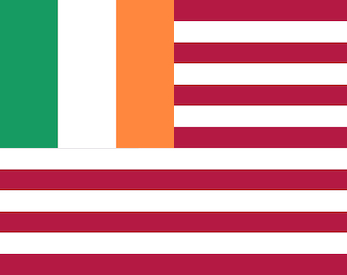
Irish American















Published on 17 March 2024 by Andrew Owen (3 minutes)
My mom grew up in Queens, New York City. American food has always been a part of my life. But after emigrating to Ireland, I’ve come to realize that a lot of the American food I love probably has an Irish origin, particularly if it’s got buttermilk in it. The recipes here are some of my favorites that I’ve gathered on my travels, converted to metric and adapted to use locally available ingredients. This is mostly for my own reference because otherwise I have to scan through the handwritten journals where I originally wrote them down. This post will also be a convenient place to keep conversion and substitute information.
In 1793, Thomas Jefferson requested artifacts from France to enable the adoption of the metric system. Joseph Dombey was sent from France with a standard kilogram. But before he reached the US, his ship was blown off course by a storm and captured by pirates. Dombey died in captivity on Montserrat. Thus far, every subsequent attempt has also failed.
Besides the US, only two other countries have not adopted the metric system: Liberia and Myanmar. But Imperial measures continue to be used in parallel with metric in England. However, Imperial measures were codified in 1824, while customary measures are based on the earlier English unit system. And so volumetric and fluid measures differ between the systems.
The National Institute of Standards and Technology, part of the US Department of Commerce has produced a handy guide for converting US customary measures to metric.
| Symbol | When you know | Multiply by | To find | Symbol |
|---|---|---|---|---|
| oz | ounce | 28.35 | gram | g |
| lb | pound | 0.45 | kilogram | k |
| tsp | teaspoon | 4.93 | mililiter | ml |
| tbsp | tablespoon | 14.73 | mililiter | ml |
| c | cup | 0.24 | liter | l |
| pt | pint, liquid | 0.47 | liter | l |
| °F | degree Farenheit | subtract 32, then divide by 1.8 | degree Celsius | °C |
But those aren’t the only US measures used in recipes. Here’s a conversion table for the other common ones.
| Item | Measure | Multiply by | To find | Symbol |
|---|---|---|---|---|
| butter | stick | 113.40 | gram | g |
| flour | cup | 125.00 | gram | g |
| rice | cup | 195.00 | gram | g |
| rolled oats | cup | 90.00 | gram | g |
| semolina | cup | 167.00 | gram | g |
| sugar | cup | 200.00 | gram | g |
| sugar (icing) | cup | 125.00 | gram | g |
And to further confuse matters, there are three different values for teaspoons and tablespoons depending on if they are US (smallest), metric (US rounded up), or UK (+1 ml and +3 ml resplectively).
The US and Ireland differ in how they grade flour. Cake flour is about 5 to 8% protein, the lowest amount compared to other flours. It’s made from soft wheat and milled extra fine. The nearest substitute I’ve found in Ireland is Odlums Cream Plain Flour. It’s 9% protein, but contains at least some Irish wheat, which has a lower gluten content.
Heavy whipping cream is a staple of American baking, but it’s unavailable in Ireland. However, it can be created by mixing single and double cream in a ratio of 11 parts double cream to 7 parts single cream.
Typically, to convert from fresh to dried divide by three, and to convert from dried to fresh multiply by three. Also, note that American recipes refer to coriander leaves as cilantro, and use coriander exclusively to refer to ground coriander.